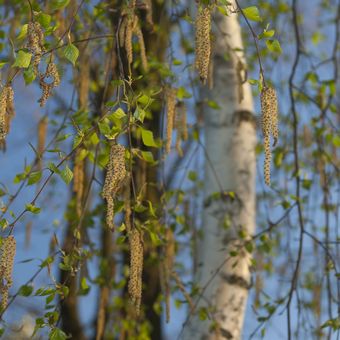Plantcompass
Birch (Betula spp.)
General Information
Family: Birch family (Betulaceae)
Flowering period in Central Europe: Early to Full Spring
Months: 4–5 (6)
Allergy potential
High allergenicity. Main allergen Bet v1, is named after the silver birch (Betula pendula). Species native to East Asia and North America show lower allergenicity.
Cross-reactions
Due to the high similarity of the main allergen, cross-reactions with alder and hazel pollen are common (Aln g1 and Bet v1 have a 90% identical protein structure). There is also a risk of pollen-associated food allergies (e.g., apples, stone fruits, nuts, carrots).
Botanical Information
Distribution
Widely distributed in the Northern Hemisphere, some species also found in tropical mountains, southernmost distribution in Florida and Vietnam. Habitats — plains to mountainous regions.
Morphology
Habit — Tree or shrub. Foliage — Summer-green, leaves egg- to triangular-shaped, leaf margin doubly serrated. Reproduction — Monoecious, ♂ catkins hanging, ♀ catkins erect, cylindrical, after maturing pendulous, winged nut fruits released individually.
Common species in Europe
Silver birch (Betula pendula).
Habit — Tree, white bark. Distribution — Open mixed forests, plains to mountainous regions, also cultivated in forestry and parks. Flowering period in Central Europe — April to May.
Dwarf birch (Betula nana).
Habit — Shrub, white bark, deciduous. Distribution — Mountainous regions up to the tree line as well as in tundra and taiga. Flowering period in Central Europe — April to May.


